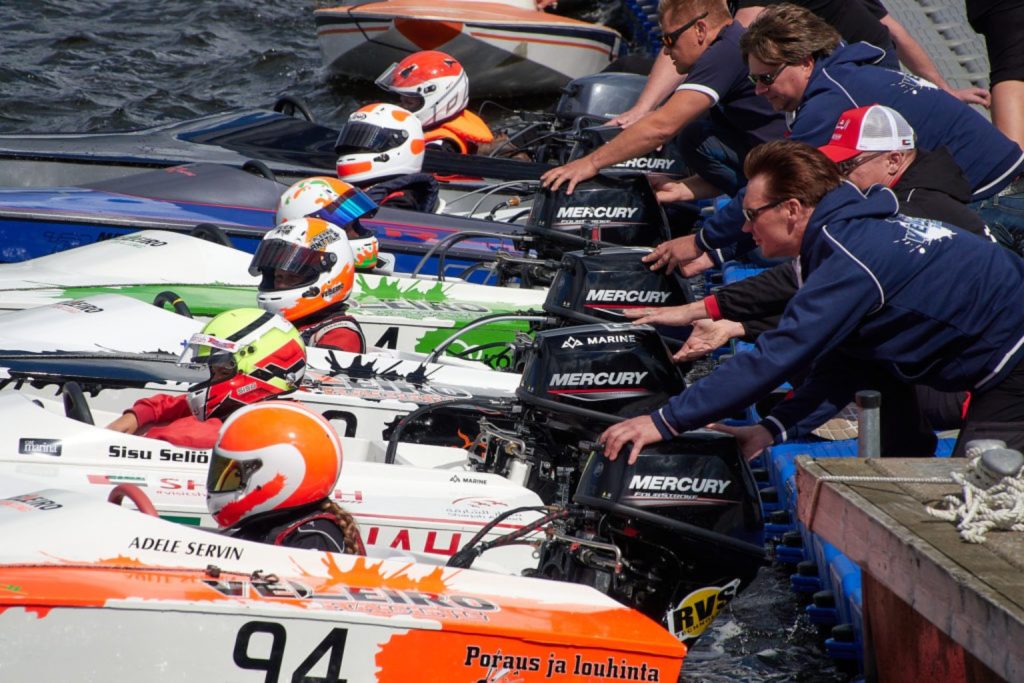It’s not uncommon to see drivers who compete at the hight of powerboat racing having offspring’s that choose a completely different sport to get involved with, one being the Seliö family.
All the two times F1H2O World Champion’s children have competed in the Optimist sailing class, which originally designed back in 1947 has since become one of the biggest ‘One-Design’ boat category in sailing. Now Seliö believes that the recently UIM recognised class of GT10 will become the ‘Optimist’ of the powerboat racing world.
GT10 is the UIMʼs “missing” class where young children can take their first step into “real” powerboat racing. The most important thing is that it makes the starting level of this sport as easy as possible for everyone. This class does not require any specific skills from the driver or parents or mechanics and provides a good foundation and knowledge of the sport.
Originally called the Sj-15 Junior Class, it was created back in 1988 in Finland by the father of Seliö, Niilo Seliö. Both he and the Finish Motorboat Federation created it with the idea of giving young children a similar opportunity that ‘Go-Karting’ gave those that wanted to start car racing but preferred to race on water. The following season the class run for 12–15-year-olds had attracted fourteen entries.
For the first ten years the class ran with 15Hp 2-stroke engines but by 1998 boats were appearing with 15Hp 4-stroke engine. Then in 2002 all engines were change to 4-stroke and by 2017 the class was changed to run only 10Hp 4-stroke engines.
The following year the RaceWKND series ran this new class and had five drivers racing. For the 2022 season they now have fourteen drivers, it would have been closer to twenty but three from last year have moved up to the GT15 class. In five years only five drivers have stopped racing, all the others are still racing GT10 or have moved up to the bigger classes.
Nuppu Böhmig from RaceWKND said
New drivers come every year and we have found the best way to get the kids to drive is to run ‘Try Out Days’ and then hopefully we can enrol them into our Academy. That’s how we get the kids in Finland onto the water.
Now with the class being an official UIM one we see its future as being a bright one. Our GT10 racers were so excited to travel last year to Lithuania to race with the drivers from the Academy run by Edgaras Riabko. Our young powerboaters can’t wait to get to more international events. So, Finland is ready to rock also in GT10 class.
To teach these young 7- to 12-year-olds good ‘race craft’ we always reverse the top ten on the starting grid after each of their four heats. That way each of them get the chance to learn to safely past each other during the race. This class is where Sami Seliö and his teammate Filip Roms along with Kalle Viippo all started their racing career, and these young drivers all see them racing in the F1H2O series.
Seliö is still very much behind this class, his son Sisu has competed regularly at the RaceWKND events and back in 2019 he was one of the drivers who put on a demonstration race before the start of the F1H2O Grand Prix of Sharjah.
The rules for the GT10 class state that the engine must be a UIM-approved, freely commercial, four-stroke standard outboard engine manufactured in 2015 or later. It must have a maximum declared power output of 10 horsepower. The engine speed limiter must not be removed or altered, giving it a top speed of 50km/h approximately 30mph. It must function as originally intended by the engine manufacturer and be in working order. No modifications, tunning or additions to the engine may be made. In terms of equipment, it must correspond in all respects to the model as intended by the manufacturer for general sale. The GT10 class approved carburettor engines are:
- Mercury F 9.9
- Tohatsu MFS 9.8
- Yamaha F 9.9
- Mariner F 9.9
- Parsun 9.8
The only approved boat hull is a Speedrace boat complying with specification in the UIM homologation file. Several UIM National Federations including Lithuania, Portugal and Sharjah have already purchased a set of moulds from the Finnish Federation and have produced the hulls. More countries have shown an interest including Ireland, Estonia, Norway, Russia, Egypt, and Fujairah.
The minimum weight of the boat is 150kg which relates to the complete rig weighed directly after the race including driver, personal safety equipment, residual fuel but without residual water.
The propeller must be selected from spare parts lists of different manufacturers (custom-made propellers are not accepted), the material must be aluminium. The propeller may be modified and shaped, but no material may be added, and the Exhaust gases must exit through the propeller hub, i.e., no holes may be drilled in the propellers.
Seliö concluded by saying
In the GT10 class children can start learning the basics of competing in a safe as well as an equal class.
After that, it will be much easier for them to move on to the GT15 class which is already more demanding.
Then it’s GT30, Formula 4 and perhaps one day they will win the F1H2O world title.














